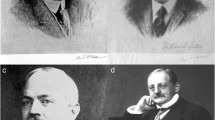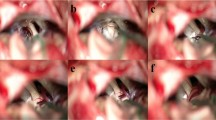Summary
Background. The Micro-Vascular Decompression (MVD) procedure – developed for conservative treatment of idiopathic Trigeminal Neuralgia (TN) is based on the NeuroVascular Conflict (NVC) theory. Although MVD has become very popular over the last twenty years, its principles and value remain controversial. Detailed anatomical observations during posterior fossa exploration in patients with idiopathic TN may help to understand better the role of NVCs.
Method. In this article, the authors report the anatomical observations made under the operating microscope in a consecutive series of 579 patients suffering from idiopathic TN who were treated by MVD.
Findings. In 19 cases (3.3%) no neuro-vascular conflict was found. In the remaining 560 (96.7%) one or several offending vessel(s) were identified. A superior cerebellar artery alone or in association with other “conflicting” vessel(s) was found in 88% of the patients, an anterior-inferior cerebellar artery (alone or in association) in 25.1%, a vein embedded in the nerve (alone or in association) in 27.6%, the basilar artery (alone or in association) in 3.5%. Of prime importance, several “conflicting” vessels were found in association in 37.8% of the patients. Location of the NVC was in the trigeminal root entry zone in 52.3% of the patients, in the midthird of the nerve in 54.3% and at the exit of the nerve from Meckel cave in 9.8%. The relation of the predominant conflict with the surface of the nerve was supero-medial in 53.9%, supero-lateral in 31.6% and inferior in 14.5%. The degree of severity of the main conflict was a simple contact with the nerve in 17.6%, a distorsion of the nerve in 49.2% and a marked indentation in 33.2%.
Alteration of the whole trigeminal nerve was frequently observed. In 42% of patients, the nerve had a significant degree of global atrophy. In 18.2%, there was a local thickening of arachnoid membranes, adherent to the nerve. In 12.6%, the root had a marked angulation on crossing over the petrous ridge. Finally in 3.9%, the nerve was compressed between pons and petrous bone, due to the small size of the posterior fossa.
Interpretation. It is concluded that NVC in this series played an important role as a causative factor of the neuralgia, as classical; but other – possibly responsible – anatomical factors were found, especially a global atrophy of the root, a focal arachnoid thickening, a ribbon-shaped and angulated root on crossing over the petrous ridge . . .
Similar content being viewed by others
Author information
Authors and Affiliations
Rights and permissions
About this article
Cite this article
Sindou, M., Howeidy, T. & Acevedo, G. Anatomical Observations During Microvascular Decompression for Idiopathic Trigeminal Neuralgia (with Correlations Between Topography of Pain and Site of the Neurovascular Conflict). Prospective Study in a Series of 579 Patients. Acta Neurochir (Wien) 144, 1–13 (2002). https://doi.org/10.1007/s701-002-8269-4
Issue Date:
DOI: https://doi.org/10.1007/s701-002-8269-4




